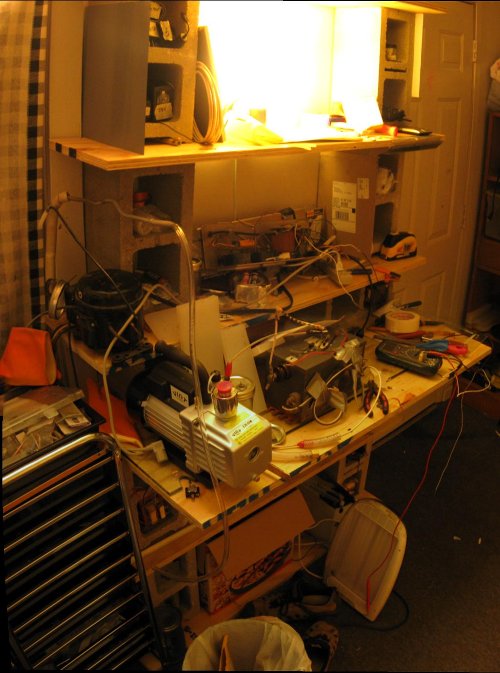pyroelectric particle accelerator

The basic operation of a pyroelectric crystal particle accelerator is as follows: A single crystal of some tens of mm in thickness that is radially symmetric is grown. This crystal is cleaved to expose the pyroelectric faces and is attached to a heating (or cooling) element. This combination is then put into a moderate vacuum of 10^-3 to 10^-4 torr wherein a significant portion of dilute gases remain but the mean free path is greater than the radius of the vacuum container ensuring molecular flow regime. The crystal is put through heating and cooling cycles which induce extremely high electrical fields on the pyroelectric faces of the crystal. In atmospheric pressure these electrical fields are masked by ionization and attachment of opposing ions from the air on the pyroelectric faces, but in vacuum this is not complete. This electrical field then ionizes and accelerates, depending on crystal face and temperature change direction, either the positive ions from the dilute gas ionization or electrons from the same. With crystal thicknesses of a centimeter or so energies of up to 200KeV have been recorded. With radially symmetric crystals these particle beams are self focusing.

This process (minus crystal growth) and theory is best explained in the paper by James Brownridge, "Electron and Positive Ion Beams and X-rays Produced by Heated and Cooled Pyroelectric Crystals such as LiNbO3 and LiTaO3 in Dilute Gases: Phenomenology and Applications" and usually uses first order pyroelectric crystals such as Lithium Tantalate or Lithium Niobate. But these are extremely difficult to grow and very expensive to purchase in sizes larger than a half a millimeter thick.
I re-host a number of technical papers on the subject in the reference archive.
It is my intention to grow perfect single crystals of triglycine sulfate (TGS) oriented along the monoclinic b-axis. I will construct a crystalizing chamber with temperature control for use with Sankaranarayanan-Ramasamy method of crystal growth. I believe that even though triglycine sulfate is a second order pyroelectric (heat expands it first, then that changes piezo effect), it should be enough to ionize and accelerate dilute remaining gases and electrons in moderate vacuum. Electron emission from TGS has been reported in the literature for decades. In order to visualize the ions I will use stacked layers of polyethylene naphthalate scintillation film.
Triglycine Sulfate Single Crystal Growth...

In the past I have used battery grade sulfuric acid and reagent grade glycine powder which is heated above 60C. I then slowly lowered the temperature of the covered solution on the stirring hotplate over a day to 35C, where the above solution would be just barely supersaturated. The solution was then put onto a large pan and evaporated for (crappy) seed crystals and purification. For references about how to perform this process and what ratios to use I read the invaluable, "Pyroelecticity: Triglycine sulfate crystal growth and characterization" by Yu Preezant and Y Preezant. and their lab write-up website at: http://physics.technion.ac.il/~jammia/advlab/advlab.htm

That made small seed crystals. To grow larger single crystal I am slowly implementing the design of a Sankaranarayanan-Ramasamy method crystallizer. I have bought and assembled a PID temperature controller with solid state relay and and platinum thermistor with 0.1C accuracy using the below listed parts.
http://www.lightobject.com/JLD612-Dual-Display-PID-Temperature-Controller-P43.aspx http://www.lightobject.com/Water-resistant-PT100-RTD-01-degree-Sensor-Probe-P592.aspx http://www.lightobject.com/25A-Solid-State-Relay-SSR-DC-In-AC-Out-P61.aspx http://www.lightobject.com/Heat-sink-for-25A-SSR-P583.aspx
I also bought a number of 25 and 50ml conical glass centrifuge tubes to use as the actual crystallizer containers off Amazon.com: http://www.amazon.com/Centrifuge-Tube-Glass-Tapered-beaded/dp/B00187XOO8/ref=pd_sbs__1
I will use this 110VAC source to heat a stove heating element bent into a ring which is covered in plumbers' epoxy and sodium silicate (waterglass) to make it water tight. The temperature will never rise much above 70C so cracking will not be an issue. This temperature controller setup and heating element can than be used to replicate the S-R method as described in, "Growth of TGS crystals using uniaxially solution-crystallization method of Sankaranarayanan-Ramasamy". Seed crystals of defined faces will be selected from the first rapid drying process. The supersaturated solution will be prepared from the remaining marginal seed crystals and water for reasons of purification.Using the S-R heater and crystallizer shape design with the crystallizer insultation design from Pyroelecticity_ Triglycine sulfate crystal growth and characterization, I should be able to grow properly oriented large single crystals from which to cleave and polish centimeter scale radially symmetric crystals oriented with the pyroelectric faces along the long axis.
The vacuum system,

VPD3: 2-Stage Rotary Vane High Performance Deep Vacuum Pump 2.85 CFM Intake ports:1/4&3/8"SAE MFL DO not run the pump at the max vacuum for over 30 minutes. 2,75cfm,78l/m, 4.67m^3/h,1.30l/s,15 micron, 2pa, 0.5906*10^-3 inchHg,1/3Hp, 1720r/m,380ml oil, 305x143x265cmm,11.5Kg.
Need to use bought 13x molecular sieve with some high conductance attachment to the bell jar. 3/8"? 3/4"? Can bake-out with remaining feet of heating rope, or just an oven...
Increase conductance: More to full 3/4", output is a 3/4" to 3'8" tee. Remove T-valve. Get full 3/4" output brass. Get some o-ring help. Good materials for the in-vacuum insulators are high density polyethylene, acrylic plastic, epoxy, or Teflon (when the Teflon is not stressed enough to flow plastically)
KF Flange best value, but too expensive for initial design unless directly needed (like off vacuum pump). Should just JB weld everything.

- Ran some low pressure, dark striations visible, in a mason jar with an center grounded neon sign transformer.
- Make the TGS vacuum chamber, test it. Visible or not? Water or spray foam?
- Get the two newly wired properly grounded half-wave 12kV NST wired up in serial.
- Test out electrostatic acceleration without TGS heating.
- Extensive crystaligraphic identification and laborous cutting.
- Heat the TGS crystal of a monoclinic b-axis (010) of at least a cm in a dilute atmosphere (10^-4 torr) of natural air gas from 20 to 50 C over some tens of minutes and let it cool, look for flourescence on a PEN sheet at 425nm
Scintillator particle detector
Finding a source of PEN, polyethylene naphthalate, that was not in the form of a rolled hazy film of resin was a minor chore. This material scintillates with high energy radiation and puts out 425nm (Evidence of deep-blue photon emission at high efficiency by common plastic), making it perfect for a cheap particle detector. I've sampled the clearest 'non-hazy' sample I can from a Tekra redistributor and it is very clear.
I'll try to make use of, for detection scintillators. Its 2 sheets of 8"*11" 3 mil thick but I can cut and stacked for stopping power. I think it will be a good scintillator for pyroelectric electrons.
Other references for all categories:
If the gas pressure is high (1 atm) then polarization charge will be neutralized almost as fast it appears in the surface of the crystal. On the other hand, if the gas pressure is low (<10-6 torr) then there will not enough gas to provide charge at a rate equal to the rate of polarization charge production, consequently, uncompensated charge will appear in the surface of the crystal. If the pressure is in the 2 mT to 3 mT range, polarization charge production and charge compensation will be completed in less than 30 minutes and the maximum electron energy will be more than twice that observed when the pressure was <10^-6 Torr. When the pressure is high (>~0.5 mTorr) there is build up or stacking of dipoles near the surface of the crystal, they are aligned with the crystal E field thus forming plasma extending from the surface of the crystal. As the pressure rises through about 3 mTorr the (electron) beam begins to defocus and become unstable. As the pressure rise to about 8 mTorr and the beam blows up in runaway ionization of gas around the crystal. Maximum electron energy for dilute air is at 2 mTorr (10^-6), 10^-7 has no gas amplification, 10^-5? 10^-4? 10^-2 replaces charge too quickly; but with a small volume this might be mitigated. In general as the pressure is raised from a pressure below about 0.1 mTorr towards about 10 mTorr the electron energy will increase to a maximum and then begin to decrease. Of course, ion energies are flat.
6 times (10^(-3)) mbar = 0.0045 torr
...pressures in the range of 10^-3 Torr the beam may only last for several minutes and at a slightly higher pressure it will not stabilize or focus well, (see Fig. 23) at yet higher pressures (8-10 mTorr (9x10^-2 torr)) the forming beam will "blow up", as shown in Fig. 24, a runway ionization of the gas around the crystal.
zeolite trap: A common commercial design is composed of a stainless steel mesh cage contains an array of 13-X (10A) molecular sieve pellets with a pore size to match the diameter of the oil molecules so that the oil is trapped and held within the pores. Fresh, pre-baked molecular sieve will trap and hold large quantities of oil efficiently, but the sieve will also trap water molecules which enter the trap during pumpdown of the chamber. Since water molecules are physically smaller than oil molecules, the water can be selectively absorbed and cause displacement of the oil which can then easily enter the chamber. In a system that is cycled between vacuum and atmospheric pressure regularly, the amount of water pumped can saturate the trap long before it is saturated with oil. [alkali metal alumino-silicate, in the sodium form of the Type X crystal structure, Na2O. Al2O3 2.45SIO2. 6.OH2O]
inline zeolite trap built under the vacuum chamber. half-pint mason jar for trap body. Copper tubing epoxied (and baked at 350F) goes into and supports main vacuum tube chamber. Tray for dryice+acetone to cool the trap.
Duniway MATERIAL QUANTITY* Price FT-4-MS Zeolite - 13X - Molecular Sieve Can – 1 # $22.00 MS-13X Zeolite - 13X - Molecular Sieve Bottle 1/2 Gallon (2 # 10 oz.) 38.00
"...uses a combination of silica gel and Molecular Sieve 13X to remove water vapor, followed by Molecular Sieve 5A to sorb CO2. This combination is necessary because water vapor seriously inhibits the adsorption of carbon dioxide by 5A.

[comment on this post] Append "/@say/your message here" to the URL in the location bar and hit enter.


